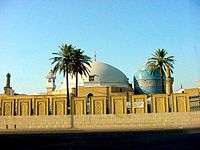Baha-ud-din Zakariya
| Baha-ud-Din Zakariya بہاؤ الدین زکریا | |
|---|---|
|
| |
| Religion | Islam, specifically the Suhrawardiyya Sufi order |
| Personal | |
| Born |
Friday, 4 June 1171 Karor Lal Esan, Punjab |
| Died |
Thursday, 21 December 1262 (aged 91) 8th Safar 661 H. ٧ صفر ٦٦١Multan, Punjab |
| Senior posting | |
| Based in | Multan, Punjab |
| Title | Hadrat, Sheikh (Ghous-ul-Aalamin) |
| Period in office | 12th/13th century |
| Predecessor | Shahab al-Din Suhrawardi |
| Successor | Various, including lal Shahbaz Qalander, Fakhr ud din Iraqi, Jalal ad-Din Muḥammad Rumi and Sayyid Jalaluddin Surkh-Posh Bukhari |
Baha-ud-din Zakariya (Persian: بہاؤ الدین زکریا) (1170-1267), also spelled as Bahauddin Zakariya, and also known as Baha-ul-Haq and Hazrat Bahauddin Zakariya Multani (Rahmatullah Alaih), was a Sufi of Suhrawardiyya order (tariqa). His full name was Abu Muhammad Bahauddin Zakariya. He was from the lineage of Hadhrat Asad Ibn Hashim hence Hashmi.
Sheikh Baha-ud-Din Zakariya was born at Kot Kehror (Karor Lal Esan), a town of the Layyah District near Multan, Punjab, Pakistan, around 1170. His grandfather Shah Kamaluddin Ali Shah Qureshi arrived in Multan from Mecca en route to Khwarezm where he stayed for a short while.[1]
In Tariqat, he was the disciple of renowned Sufi master Shaikh Shahab al-Din Suhrawardi who awarded him Khilafat only after 17 days of stay at his Khanqah in Baghdad. For fifteen years, he travelled to different cities in order to preach Islam and finally settled in Multan in 1222.
Writings
- Awrad-e-Shaikhush Shuyukh: Al-Awrad : Awrad-e-Suhrawardy
( اوراد شيخ الشيوخ : الاوراد : اوراد سهروردي)
His Shrine
Coordinates: 30°12′02″N 71°28′35″E / 30.20056°N 71.47639°E

Baha-ud-Din Zakariya died in 1268 and his mausoleum (Darbar) is located in Multan. The mausoleum is a square of 51 ft 9 in (15.77 m), measured internally. Above this is an octagon, about half the height of the square, which is surmounted by a hemispherical dome. The mausoleum was almost completely ruined during the Siege of Multan in 1848 by the British, but was soon afterward restored by Muslims.[2]
Many pilgrims visit his shrine at the time of his urs from different parts of Pakistan and beyond.
Descendants
Baha-ud-din Zakariya had seven sons who gained fame in their own right as great Sufis - Shaykh Sadruddin Arif, Shaykh Burhanuddin, Shaykh Ziauddin, Shaykh Alauddin, Shaykh Qudrat-ud-din, Shaykh Shahab-ud-din, and Shaykh Shams-ud-din. Shaykh Sadruddin Arif's son was the famous Sufi Shaykh Abul Fath Ruknuddin, also known as Shah Rukn-e-Alam. His progeny dispersed all over Indian subcontinent during the coming centuries and produced many famous people in all walks of life and scholarship. Today his descendants are found in Multan, Karor Lal Esan, Islamabad, Rawalpindi, Qureshi Morh (Dera Ismail Khan), Shaykh Yusuf (Dera Ismail Khan), Main City (Dera Ismail Khan), Near Gomal University (Dera Ismail Khan), Paniala (Dera Ismail Khan), Gujrat, Gujar Khan, Watli (Chakwal), Pir Khara (Chakwal), Karoli Piran (Chakwal), Dharabi (Chakwal), Pail Piran (Khushab),[3] Tibba Qaim Din (Khushab), Bhera (Sargodha), Purmiana (Attock), Lahore, and Hazara. In Hazara, Sufi saint Hazrat Mian Mohammad Niaz, forefather of Hazrat Qazi Mir Aalam Qureshi, is buried in Basian Berote Kalan. His descendants are also found in India in the cities of Delhi, Meerut, and Allahabad. Since the independence of Pakistan in 1947 many of his descendants from India have migrated to Khushab, Bhakkar, Layyah, Mianwali. Some of his descendants use Hashmi while some use Qureshi with their name. Some of his descendants use as Qureshi Hashmi. Makhdoom Pir Javed shah Hashmi is the current Sajjada Nashin of Darbar Hazrat Baha-ud-din Zakariya[4]
Memorandum
- Bahauddin Zakaria Express train is named after him, which runs between Karachi and Multan.
- Bahauddin Zakariya University located in Multan is named after him which is the largest institution in Southern Punjab.
Sufi order
Baha-ud-Din Zakariya belonged to the Suhrawardiyya Sufi order, which was well known in the Mamluk Sultanate of India. He was one of the disciples of Sheikh ul-Sheiyukh Shahabuddin Suhrawardy. Multan had come to be known as "Baghdad of the East" after he settled here. It is mentioned in the following couplet of Bahaul Haq in Persian :
Multan ma ba jannat a'la barabar ast
Ahista pa ba-nah ke malik sajda mi kunad.
(Multan of ours is comparable to the great Paradise,
Tread slowly, the angels are paying obeisance here.)
Followers' Slogans
حضرت پير بهاوالحق رح
سخي پير حضرت پير بهاوالحق رح
مدد ڪر مرشدغوٽ بهاوالحق رح
زنده آهي غوٽ رح زنده آهي غوث رح
References
- ↑ Hazrat Sheikh Bahauddin Zakariya Multani. Alahazrat.net
- ↑ University of Calcutta (1891). Calcutta review. University of Calcutta. p. 251. Retrieved 10 January 2011. This section uses content copied verbatim from this source, which is public domain.
- ↑ http://pail-piran.blogspot.com/?m=1
- ↑ Mausoleum of Shah Bahauddin Zakariya "Multan City Online".
